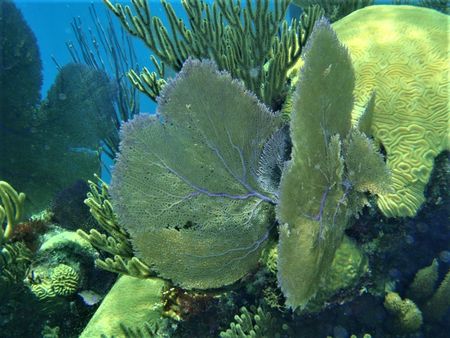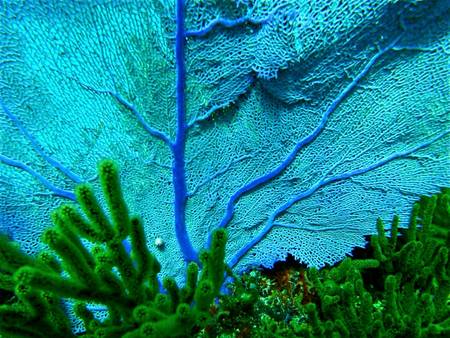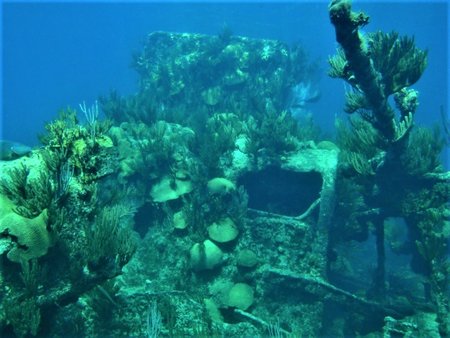Scuba diving experience in Bermuda
I was driving down the highway outside of Pittsburgh when my friend asked, “What would you do with your life if you could do anything in the world and it didn’t matter?” Without hesitation I responded, “I’d work on a dive boat in Bermuda”.
I was 25 years old and in graduate school. Less than a year later, I was being picked up at the airport by my new boss, a dive shop owner in Bermuda. I was living my dream. Unbelievable. Raise your hand. How many of you are able to say you live your dream job, in your dream place?
Blue Hole Brain Corals and Sea Fan
Photo: Heidi Hess
While I have dived my fair share of locations around the world, most of my diving experience has been in the waters around Bermuda. The island’s statistics are well known. Bermuda is 21 miles long, a mile and a half at its widest point, and made up of well over a hundred small islands.
What may not be so well known is that Bermuda is surrounded by a shallow barrier reef. Along the south shore, this reef is approximately a half mile from the main land. Along the northeast, this reef stretches out approximately 9 miles. You can be 9 miles off shore on the wreck of the Caraquet in 30-40 ft of water.
Much of the barrier reef can be seen by breaking waves, even at high tide. Locally, we call these reefs 'boiler reefs' because it looks like the water is boiling around them. However, under certain conditions these reefs cannot be seen.
If the water is flat calm and it is high tide, or the sun is at a certain position in the sky, it is as if they are not there at all making safe passage through the reef almost impossible.
Sometimes wrecks occurred when the captain of the ship was just too stubborn to heed the advice of his navigator. The Pelinaion captain refused to believe his own navigator who said they were too far east.
Reports claim he shouted if they were that far east they would see
St. David’s Lighthouse, not making the connection [Realizing] it had been blacked out due to World War II (He promptly struck the reef).
All our diving here in Bermuda is shallow: 30-80 ft for almost all sites. This makes for plenty of light, lots of aquatic life, and long bottom times. This is what I call easy diving. Relaxed diving. Sure, if you are in with the right crowd you can find technical divers here, just like anywhere.
For me, however, what I love about diving is the relaxation, the beauty, the slow-motion movements, the quiet. Bermuda has almost no thermocline and rarely will you find yourself in any current. This is what I consider ideal conditions.
Blue Hole Sea Fan
Photo: Heidi Hess
Bermuda is the farthest north that coral reef grows. We are a bit of an anomaly. The water temperature here fluctuates by 20 degrees from summer to winter. The summer temperatures can reach close to 87 degrees F, as they did this summer; but, the winter temperatures can fall below 65 degrees F.
Our sea temperatures do not reach what I consider to be 'no wet suit temperatures' until late June, but they stay warm all the way through late October or early November.
Visiting Bermuda in the springtime you will need a 7mm full suit, but as we move into the late spring and early summer it is better to opt for the 7mm shorty or a lighter weight full suit. Having this tremendous change in temperature means that what survives is hardy.
Our parrot fish are larger than those you will find in the Caribbean and you can easily find sea fans that are six feet tall or brain corals in excess of a ton.
While we have all the usual reef suspects you will find in the Caribbean, you may not find the abundance due to our temperature changes. This also means you will not find the dramatic colors found further south. But fret not.
Our sea fans are the purple of royalty, the brain corals are yellow gold, and star corals are shades of green. We have very little coral bleaching in Bermuda as the temperatures do not stay warm enough for long periods of time.
The
Sargasso Sea, which surrounds the island, has a higher salinity than the Caribbean or the Pacific. We are actually the third saltiest sea in the world behind the Dead Sea and the Adriatic. You will likely find that you need a few extra pounds of lead in order to break the first few feet of the water.
For me, I would rather be slightly chilly and wear less lead, but I may be the outlier on this one. Bermuda sits atop the edge of an underwater volcano. Once you reach the outer reef, the depths increase dramatically.
We call it 'the edge'. It quickly drops thousands of feet, but our sneaky barrier reef on top the ledge has laid claim to hundreds of ships throughout the centuries.
Our cataloged wrecks date back to the 16th century right up to current day ships that have been sunk on purpose to create artificial reef. Diving on the older wrecks you may find just ballast stone and chain, but you may also find a whole lot more.
The
wreck of the L’Herminie was a French ship of the line. In 1833, she struck the reef Northwest of Bermuda about 6 miles off shore. She is a wonderful wreck dive if you know where you are going.
Never refuse a guide if offered. In fact, ask for a guide if not offered. We took a group of divers from a popular dive magazine out to the L’Hermine and they refused a guide.
Somehow, they managed to miss the 59 cannons, brick ovens, metal water containers, and 16ft anchor wedged into the reef. But I cannot blame them. This wreckage is spread out over what is likely the equivalent of a football field.
Montana Shipwreck (Boiler)
Photo: Heidi Hess
I prefer the older wrecks. While interesting, the ships that have been sunk on are what I call 'dive sites'. They certainly are not wrecks because they do not convey the sense of history. I get it. Everyone wants to dive on a ship that looks like a pirate ship.
They want to see that mast up, captain lashed to the helm, spy glass in his eye. Discovering the reality of a centuries old shipwreck is so much more interesting.
Quite a few of our shipwrecks have dubious stories of spying and carrying contraband. Was the captain of the
Marie Celeste in the pay of both sides of the American Civil War, or was he just paid to transport illegal cargo? We may never know, but this is one wreck that all local divers love to dive after a storm.
A short swim from the original captain’s home where she struck the shallow reef, the Marie Celeste lays in 50 ft. of water. History claims the captain swam home, and the only loss of life was the chef who returned to save his cat.
In big storms, the sand shifts and moves by feet. Something interesting always finds its way up. A secret cargo hold was always suspected, but could never be proved. A number of years ago, cases of wine emerged from the depths of the sand after a storm.
Carefully brought up by marine archaeologists, the wine was uncorked and sipped by a panel of food experts at a food festival in South Carolina. According to a Reuters article by Harriet McLeod from 2015, "The verdict: A heady sulfur bouquet with distinct notes of saltwater and gasoline".
Articles place the total shipwrecks in Bermuda at different numbers. I have seen between 300 to 350 wrecks. We will never have an exact number because wreckage is constantly being discovered.
At the first shop where I worked, we would head to an area just east of Chubb’s Head Beacon. At this location there were a vast number of what we call 'blind breakers'. A blind breaker is one that never breaks the surface of the water, even at low tide.
These blind breakers make for the most amazing dive sites. The structures arise from the sea bed like champagne flutes and spread out at the top like a saucer, and then dip back down a few feet like an upside-down mushroom cap. The saucer part makes for large overhangs.
You can swim down into cavern-like formations finding huge schools of Glassy Eyed Sweepers, snapper, or even turtles resting on ledges. Some of these breakers have giant fissures right through them with huge walls on either side. I always imagine I am flying my X Wing in the canyon of the Death Star.
On top of these blind breakers, in very shallow water, it is like swimming in an aquarium. Blue headed wrasse, chromis, tangs, parrot fish, and sticky urchins abound. Our shop named this area 'The Badlands'. When we would head to The Badlands, we rarely visited the same site twice.
We drove the boat around until we found the right combination of breaker heads and a sand hole in which to anchor. On several occasions we incidentally found "inconceivable" wreckage from unnamed and unclaimed wrecks. However, copper sheeting, old iron nails, bits of wood and lots and lots of broken china and glass were normal to find.
Diving in Bermuda is special. We are not the Caribbean, we are not Fiji, and we are not the Great Barrier Reef. Do not come to Bermuda expecting it to be like other places you have you dived. We are in the North Atlantic, closer to Canada than to the Caribbean.
My advice to all divers is to dive each new place with wonder. View it as a time to learn new information about the Ocean and maybe even about yourself. You will be very happy you added Bermuda to your bucket list of dive destinations.
|
Article By: Heidi Hess
Heidi is a PADI Open Water Scuba Instructor and boat pilot with over 25 years in the SCUBA Diving and tourism industry in Bermuda. She holds a Master Degree in Education from Duquesne University.
She has lived and worked in Pittsburgh, London, and Bermuda. In addition to diving she loves travelling, photography, art history, eating and cooking great food, watching films of all genres She considers herself a pop culture junkie.
Heidi is originally from Pennsylvania, but considers Bermuda her spiritual home. She currently works at the Island Tour Centre, Bermuda where you may reach her or any staff to book all your Bermuda adventures.
|
Related Articles
3)
Activities: Know all about the exhilarating activities and adventures in Bermuda


